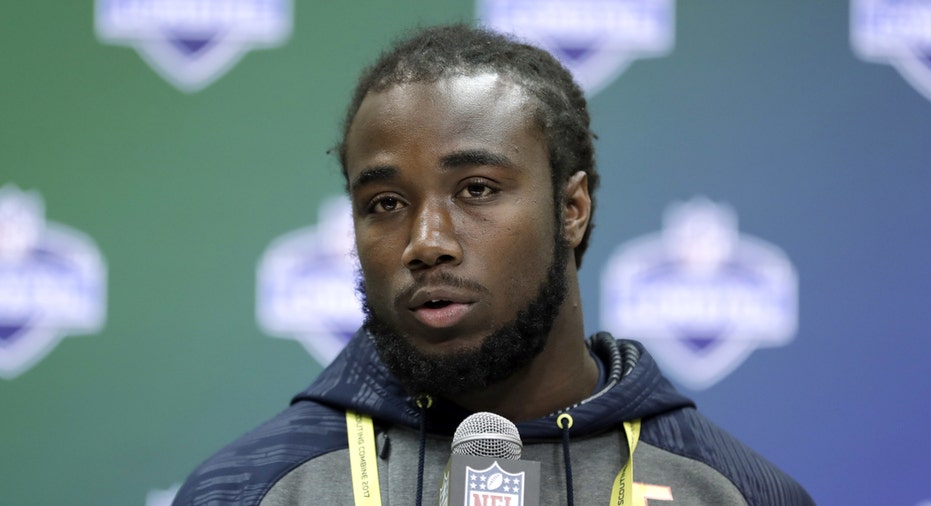NFL Teams Finding Better Value in Running Back Revival

INDIANAPOLIS – As Todd Gurley and Ezekiel Elliott spent the past two years crashing through conventional wisdom, Dalvin Cook saw the NFL's two emerging stars as something bigger.
He viewed them as change agents, as role models, as trendsetters, paving the way for college football's next great runners.
Now, with a whole group of backs ready to cash in on the success of Gurley and Elliott, Cook is looking to do more than join the cause. He wants to create his own story in the league's running back revival.
"After that draft class with Todd and Melvin (Gordon), and then Ezekiel came after those guys, I've definitely seen it (the value of running backs) go up," Cook said Thursday at the league's annual scouting combine. "If you put us in the right system, we can help teams win ball games."
It sounds strange coming from a league that once treated workhorse feature backs with the reverence of today's franchise quarterbacks.
But as the rules changed, the passing game opened up and the salary cap became more prohibitive, team officials searched for younger, cheaper answers.
Former Denver Broncos coach Mike Shanahan was so masterful at using late-round draft picks or even undrafted rookies behind his seemingly invincible zone-blocking scheme, everyone thought they could do it. Others tried, with mixed results.
Then came the dual-backfield craze. The concept was two solid backs were better than one great one because they could stay healthier and productive.
That was followed by the over-30 idea — don't waste money on an over-the-hill back. The stats mostly backed it up.
The result: Each philosophical adaptation made running backs less valuable on draft weekend.
From 2012-2016, only four running backs were taken in the first round and none was selected in 2013 or 2014.
Things are changing again.
After Seattle rode Marshawn Lynch to a Super Bowl title and almost a second, Gurley broke the first-round drought and became the 2015 Offensive Rookie of the Year.
Elliott won the 2016 NFL rushing title and led Dallas to the top seed in the NFC, and Atlanta won the NFC championship by using essentially two productive feature backs to give quarterback Matt Ryan more balance on offense.
"Running backs went through this period of — we blame that on Denver and Mike Shanahan, where you can always get your running back in the seventh round," said Rams general manager Les Snead, who drafted Gurley.
"The year we drafted Todd, and even Melvin Gordon, kind of opposite years, right? He had a freshman slump, Todd had a sophomore slump. They get drafted in the first round, they ended up producing. Ezekiel Elliott, put that guy behind that line and guess what? Defenses have problems.
"This year, you have another group of running backs who are pretty good. They're going to go first round and they're going to help teams."
With LSU's Leonard Fournette , Cook from Florida State and Stanford's Christian McCaffrey all projected to go in the first round, it could be the deepest running back class in years.
Tennessee's Alvin Kamara could move into the first round as well and the class includes two 2,000-yard rushers — Texas' D'Onta Foreman and San Diego State's Donnel "D.J." Pumphrey.
The timing couldn't be better.
Green Bay, Detroit and Indianapolis went into the offseason looking for backfield help and after releasing longtime stalwarts Adrian Peterson and Jamaal Charles , Minnesota and Kansas City could be in the market, too.
And teams looking to follow Atlanta's model could be looking for more than one. Wisconsin's Corey Clement said one Packers scout told him Green Bay may draft two running backs.
"I have always thought that it was valuable when you could have two or three backs that you can run in there," Seattle coach Pete Carroll said.
"If you have one guy who is so dominant that no one else deserves playing time, then you have a great one. I don't think it's any more valuable today to have multiple backs than it was 15 years ago, but we always have been an advocate of having a one-two punch at running back."
Cook may or may not agree with Carroll's notion.
But he and the other college backs in this class are ready to prove that they can be game-breakers.
And, like Gurley and Elliott, they're not planning on wasting any time joining the club.
"With the running backs we've got in our class and next year's running backs, a lot is going to change," Fournette said.
"With this group a lot of these players are going to succeed in the NFL and contribute as soon as they get there."



















